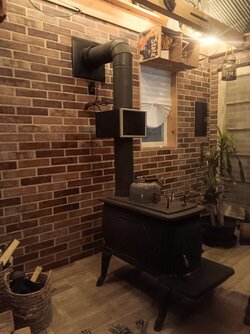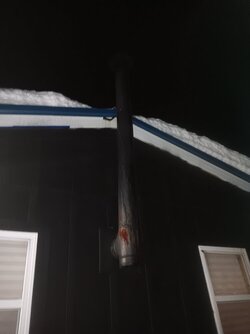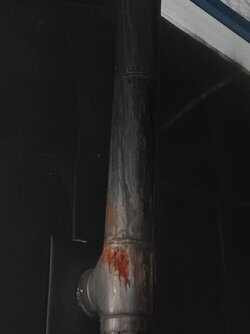When wood is burned, especially poorly seasoned wood, there is lot of water along for the ride. If you have 10 pounds of wood, well seasoned wood may be 10% moisture, so the 10 pounds of wood is actually 9 pounds of bone dry wood and 1 pound of water. Water does not burn and even though you cant see it in the wood, its liquid. In order for it to go up the stack in the flue gas, it has to be heated into steam just like a tea kettle on a stove. To convert liquid water to vapor requires a lot of heat, a lot more than just warming it up, that is why it takes so long to get water to boil. Green poorly seasoned wood may have 40% moisture content so there is only 6 pounds of dry wood that needs to boil 4 pounds of water. The energy being used to boil that water goes right up the stack and cools down any fire in the wood stove.
Mixed in with the water vapor are other compounds, a very simple example is maple sap, if you are familiar with making maple syrup. The sap looks like water but dissolved in it is sugar. As its boiled the water goes up through the roof and the sap concentrates into syrup and if overcooked it will turn into black goop before turning solid. The other problem is that with all that water, the fire does not burn hot enough to burn the wood and the other compounds completely. Carbon Monoxide is the stuff formed by burning wood too cold that kills people, but it does not condense, it either goes up the stack or into the house. There are lots of other compounds mixed in with wood that do the same thing but they turn into a gas that can condense out when cooled. As long as the water stays as vapor when it leaves the stack its less of a problem and the nasty gases go out into the outside air but if the chimney is cool, less than 212 Degrees F, the water vapor in the flue gas will condense on cooler surfaces. A lot of the other nasties have a lower boiling point and they will also condense out. It's the same process that makes water condense on the outside of cold glass on a humid day, the bead form and run down the sides of the glass and leaves a ring. The resultant sludge in the stack or a pot left on the stove is creosote.
When vapor condenses, its a liquid and it runs down the pipe back into the stove to be heated up again if the stove pipes seams are pointed in the correct direction (pointed so that the crimps in the pipe are headed down. When pipe is sold its comes with one crimped end and most stoves and heat reclaimers are sold with round rather than crimped entrance. So a DIY person cuts the pipe to length cutting the smooth easy end of the pipe and sticks the store bought crimped end into the round collars on the equipment and its easy to get the pipe "upside" down.
Chimneys, especially uninsulated ones or ones on outside walls cool off the stack gases by giving off heat. and that means those flue gases cool off as they go up to the roof Adding in a heat reclaimer set at 160F is just asking for the flue gases to condense out and end up somewhere, either back in the stove or somewhere up in the stack forming liquid and then solid creosote. Give it long enough and it can choke off the chimney. This creosote if heated up enough will burn and its just a matter of time until there is chimney fire. When the creosote is heated up back into a gas it burns like rocket fuel, as it burns it melts more and more creosote into a gas that then makes the fire hotter. A chimney fire can destroy chimneys and burn down houses.
My guess is your recent problems are probably largely caused by burning poorly seasoned wood at low stove output prior to the recent midwest cold snap. The stove is being burned hotter to heat the house and the creosote already in the stack is melting and running down the chimney. It is usually a sign that a chimney fire is imminent. If you bought the wood, despite assurances from the seller, its highly likely it's not fully seasoned. It is easy to check using the right technique and inexpensive moisture meter but if it's checked after its delivered, unless the seller takes it back, you are stuck with green wood and the only way to get it dry is restack it in sunny place with its top covered for several months.





